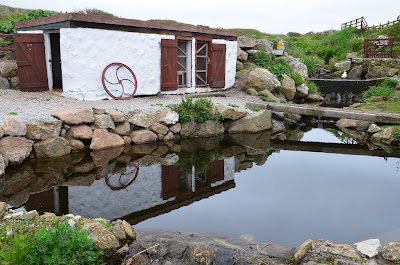Day 1 of our visit included visits to Penzance, Land's End and some very interesting sites.
We stayed at Keigwin House in Penzance. A nice quiet B&B.
Greeb Farm sits right at the end of the coast.
Kathy was in heaven with all of the varieties of chickens and farm animals.
Meet Elvis
Mom's newest friend
The Land's End coast has beautiful cliffs
The signpost at Land's End is 3147 miles form New York and 874 from John O'Groats in Northern Scotland, the top of Great Britain
This is a beautiful lighthouse along the coast
Here are some very interesting stones out in the middle of a field: Mên-an-Tol. Below the three pictures is an entry from Wikipedia about this site.
A three dimensional 101 (see description below).
Mên-an-Tol
From Wikipedia, the free encyclopedia (The full link from Wilipedia is http://en.wikipedia.org/wiki/M%C3%AAn-an-Tol)
Mên-an-Tol
A view through the Mên-an-Tol holed stone
The Mên-an-Tol (also Men an Toll) is a small formation of standing stones near the Madron-Morvah road in Cornwall, United Kingdom (grid reference SW426349). It is about 3 miles north west of Madron. It is also known locally as the "Crick Stone". The name Mên-an-Tol in the Cornish Language, literally means "the hole stone". It consists of three upright granite stones: a round stone with its middle holed out with two small standing stones to each side, in front of and behind the hole. When seen at an angle from one side, the stones form a three-dimensional "101" (see picture). These stones might have been the entrance to some now vanished tomb. It is possible that they were part of some ancient calendar.
Mên-an-Tol is supposed to have a fairy or piskie guardian who can make miraculous cures. In one case a Changeling baby was put through the stone in order for the mother to get the real child back. Evil piskies had changed her child and the ancient stones were able to reverse their evil spell.[1]
Local legend claims that if at full moon a woman passes through the holed stone seven times backwards, she will soon become pregnant.
Another legend is that passage through the stone will cure a child of rickets (osteomalacia). For centuries, children with rickets were passed naked through the hole in the middle stone nine times. Its curative powers actually are reflected in its name. The circular stone aligns exactly with the centre stone at Boscawen-Un and the church at nearby St Buryan. While this may conceivably be coincidental, the precision of the alignment suggests an intentional positioning of the structures in relation to each other.
The only other holed stone in Cornwall of this type is known as the 'Tolven Holed Stone' which can seen in a garden near Helston.
Another very interesting stone formation is Lanyon Quoit. Here is a description from the following website (http://www.lookaroundcornwall.com/historical-sites/lanyon-quoit.htm).
Lanyon Quoit is probably one of the best-known of Cornwall's ancient monuments, dating from the Neolithic period (3500-2500BC). The huge capstone originally stood atop four upright stone columns, but it crashed to the ground, smashing some of the stone supports during a storm in 1815.
The quoit was subsequently re-erected, at right-angles to its original position, on top of what remained of the uprights. Originally tall enough for a horse and rider to pass beneath, it now stands a little over a metre tall. If you feel at ease beneath several tons of stone you can sit comfortably underneath Lanyon Quoit.
It is believed that Lanyon and other quoits in the area were used as ritual funeral sites. It's possible that bodies were laid on top of the capstone to be eaten by carrion birds. Similar sites show evidence of bones from several individuals, and it's thought that bones were moved to sites such as Lanyon and used in rituals, perhaps involving attempts to communicate with ancestors and the spirit world.
Cornwall is also famous for tin mining. There are hugh mine stacks that dot the land. We saw dozens of these as we drove around the area.
Chysauster Ancient Village was an extremely interesting place to visit. It is the remains of a ancient stone-walled village dating back to 400 BC to 43 AD.



































